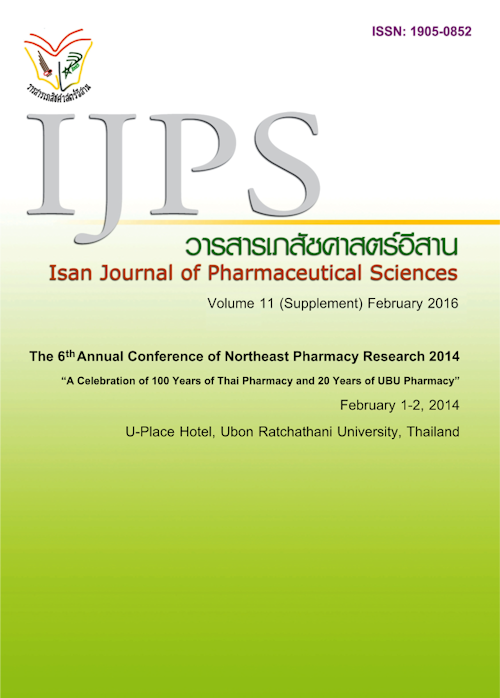Determination of Biomarker in Cassava leaves and the Minimization of Cyanogenic Glycosides
Main Article Content
Abstract
Introduction: Cassava is one of the major crops of Thailand cultivated mainly for food and tapioca flour. Cassava root is the main part-used of cassava whereas the leaves are by-products used in animal feed as a source of protein. The current study aims to promote the use of cassava leaves focusing on the biomarker compounds of 3 selected cassava cultivars (Rayong 9, Huay Bong 60 and Mun Ha natee) and the minimization of cyanogenic glycosides (linamarin) in cassava leaves (Huay Bong 60). Materials and Method: All 3 cultivars of cassava leaves were collected from KhonKaen field crops research center. Fresh leaves of three cassava cultivars (Rayong 9, Huay Bong 60 and Mun Ha natee) were extracted with 80 % ethanol. The extracts were used to study TLC chromatogram and to identify the biomarker compound of each cultivar. Fresh leaves of Huay Bong 60 were fermented with various traditional recipes using sugar and salt at various ratio. The extracts were analyzed for the linamarin and biomarker compound using the validated TLC densitometer. Results: Rutin was found as a biomarker in leaves of three cassava cultivars at Rf 0.40 ± 0.02. The solvent system was ethyl acetate: formic acid: glacial acetic acid: water with the ratio 100:10:10:12, respectively.The optimal ferment recipe for the leaves of Huay Bong 60 was fresh leaves with sugar and salt in the ratio of 4:1:1 by weight, respectively. Linamarin was not detected in both fresh leaves and fermented leaves. Whereas the content of rutin in fresh leaves and fermented leaves were 3.17 ± 0.07 % and 0.87 ± 0.04% fresh weight, respectively. Conclusion: TLC densitometry is a rapid and convenient technique to determine and compare rutin content in various cultivars of cassava leaves. The existence of rutin, an antioxidant compound with the capillary-protective action, as a biomarker in cassava leaves is particularly encouraging. Cassava leaves can be used as new source of rutin or develop them to the health food supplement in the future.
Article Details
In the case that some parts are used by others The author must Confirm that obtaining permission to use some of the original authors. And must attach evidence That the permission has been included


